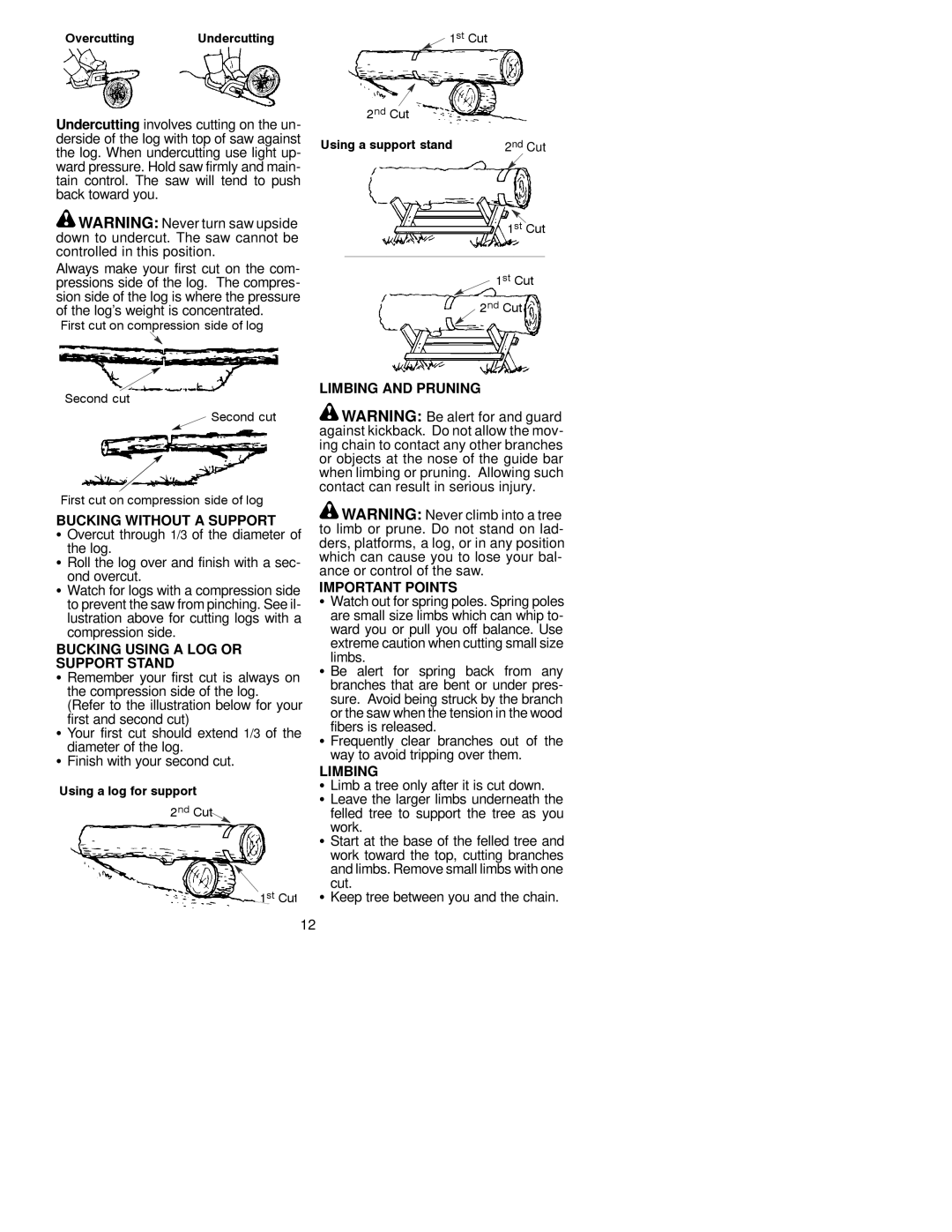
Overcutting Undercutting
Undercutting involves cutting on the un- derside of the log with top of saw against the log. When undercutting use light up- ward pressure. Hold saw firmly and main- tain control. The saw will tend to push back toward you.
![]() WARNING: Never turn saw upside down to undercut. The saw cannot be controlled in this position.
WARNING: Never turn saw upside down to undercut. The saw cannot be controlled in this position.
Always make your first cut on the com- pressions side of the log. The compres- sion side of the log is where the pressure of the log’s weight is concentrated.
First cut on compression side of log
1st Cut
2nd Cut
Using a support stand | 2nd Cut | ||
|
|
|
|
1st Cut
![]()
![]()
![]() 1st Cut
1st Cut
2nd Cut
Second cut
![]()
![]()
![]() Second cut
Second cut
First cut on compression side of log
BUCKING WITHOUT A SUPPORT
S Overcut through 1/3 of the diameter of the log.
SRoll the log over and finish with a sec- ond overcut.
SWatch for logs with a compression side to prevent the saw from pinching. See il- lustration above for cutting logs with a compression side.
BUCKING USING A LOG OR
SUPPORT STAND
S Remember your first cut is always on the compression side of the log. (Refer to the illustration below for your first and second cut)
S Your first cut should extend 1/3 of the diameter of the log.
SFinish with your second cut.
Using a log for support
2nd Cut
1st Cut
12
LIMBING AND PRUNING
![]() WARNING: Be alert for and guard against kickback. Do not allow the mov- ing chain to contact any other branches or objects at the nose of the guide bar when limbing or pruning. Allowing such contact can result in serious injury.
WARNING: Be alert for and guard against kickback. Do not allow the mov- ing chain to contact any other branches or objects at the nose of the guide bar when limbing or pruning. Allowing such contact can result in serious injury.
![]() WARNING: Never climb into a tree to limb or prune. Do not stand on lad- ders, platforms, a log, or in any position which can cause you to lose your bal- ance or control of the saw.
WARNING: Never climb into a tree to limb or prune. Do not stand on lad- ders, platforms, a log, or in any position which can cause you to lose your bal- ance or control of the saw.
IMPORTANT POINTS
SWatch out for spring poles. Spring poles are small size limbs which can whip to- ward you or pull you off balance. Use extreme caution when cutting small size
limbs.
S Be alert for spring back from any branches that are bent or under pres- sure. Avoid being struck by the branch or the saw when the tension in the wood fibers is released.
S Frequently clear branches out of the way to avoid tripping over them.
LIMBING
SLimb a tree only after it is cut down.
S Leave the larger limbs underneath the felled tree to support the tree as you work.
S Start at the base of the felled tree and work toward the top, cutting branches and limbs. Remove small limbs with one cut.
SKeep tree between you and the chain.
